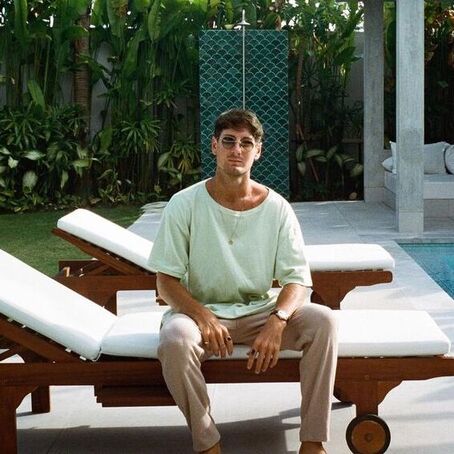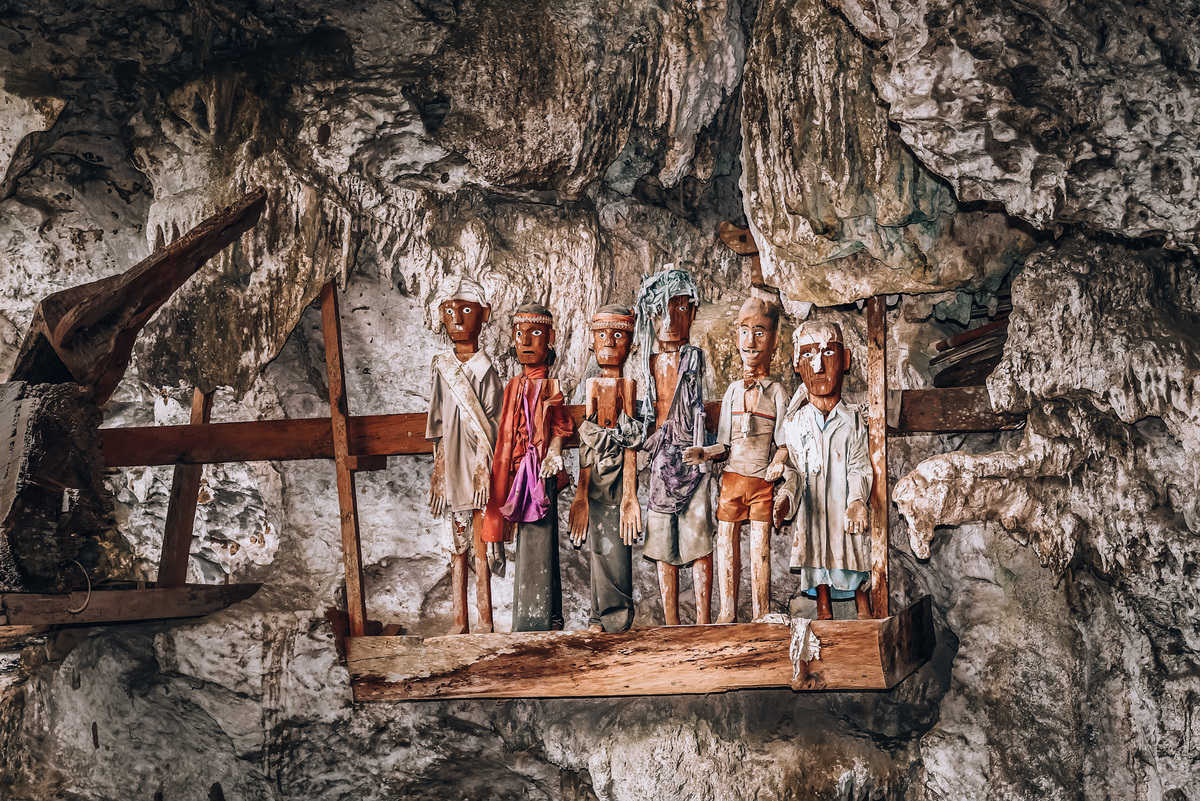“On the walls of a steep hill, coffins hang from cracks in the rocky face. Lifelike wooden sculptures or effigies complete with clothes, stand in neat rows in cracks hollowed out in the cliff faces, very much like the windows & balconies of a house. These represent the dead who are buried there.Not far from this hanging grave hides a burial cave many hundreds of years old. This site has attracted and amazed many tourists from all over the world. Be sure Londa is on your list of “Places to visit” this coming year! If you’ve never been to Londa, you’ll never know the real Toraja!”
From the customs and beliefs of numbers of tribes around the world, we come to learn how their dead are honoured and buried in very different ways. It is no secret that the people of Toraja, namely the nobility, bury their dead loved ones & relatives in one of the most unique ways in the world! A series of very costly traditional costumes for burial ceremonies (Rambu Solo) and also cave tombs high in walls of the hills and cliffs can be seen here at Londa, Tana Toraja, in the province of South Sulawesi.
Londa’s burial caves are one of the more popular tourist destinations in Toraja. Londa’s tourist attractions are found in the village of Sandan Uai, in the Sanggalangi District. It is located about 7 km. south of Rantepao City, the tourism and accommodation centre in Toraja. Therefore, Londa is easy to get to by public transport such as bemo (mini van), ojek (motorcycle taxis), or rental car.
To get to the tomb caves of Londa, one must descend a number of stairs but just before you do, you will be approached by a member of the local community offering you lanterns for rent. You will need a light to find your way into and around the cave. Aside from renting a lantern, you may also bring your own flashlight to light your way, or ask your tour guide to provide one for you. Special Londa Tour guides for the tomb caves do not normally have a fixed rate so you may bargain for a good deal.
From a distance the cliff sides appear lush & green with the forest trees. If you are observant, however, you will notice colourful coffins tucked into crevices of the cliff walls. At the foot of this lushgreen cliff lies a cave which is used as a tomb.
As you get closer to the cave you may find yourself enveloped in shades of mysticism while at the same time nature welcomes you with its wild greenery and cool mountain fresh air all about.
On the walls of the cliffs around the cave, rows of wooden statues called Tau-taus can be seen in the chiseled stone cliffs.
Tau-tau is a carved wooden effigy ,very closely resembling the dead body buried there. Usually jackfruit wood is used for this carving as it tends to yellow with age,to a colour very much like human skin. Some tau-tau are carefully carved with special attention given to details such as wrinkles on the face, or sagging skin on the neck due to aging.
Close to the rows of Tau-tau, wooden coffins are safely and firmly secured to the cliff walls by wooden beams. Apparently these hanging tombs are often thought of as another attraction of Londa,TanaToraja. These coffins or caskets (erong) are said to indicate the level of honour or nobility of the person buried there. The higher the casket or coffin is located on the cliff walls, the higher the degree or status of the bodies buried there.
The Torajans believe that the dead can take their wealth with them into the afterlife. One reason why they bury the coffins in high places is to protect the buried treasure from thieves. They also believe that the higher the coffin lies the shorter the journey is for the deceased to enter into Nirvana.
Before entering the cave, bones may be seen scattered here and there. These bones fell from a cliff-hanging coffin that broke off at some time because its wooden holds and supports were damaged or rotten with time. The fallen skulls and bones may once again be placed in a new coffin. However, expensive ceremonies have to be performed once again, similar to when the deceased was buried in its first coffin.
This customary funeral ceremony known as Rambu Solo, is an age-old tradition for deceased noblemen of Toraja. In order to carry out this ceremony, surviving relatives of the deceased sacrifice approximately 24 to 100 buffaloes (forthe nobility) or approximately 8 buffaloes and 50 pigs (for the middle class). It is not unusual for the surviving relatives to take many months or even years to save up for, or gather enough of all that is needed in order to carry out the rituals for a funeral ceremony as Rambu Solo.
While waiting for this ceremony to take place, thecorpse is not considered completely dead yet. Therefore, the dead body is stored in a traditional vernacular house (tongkonan) and treated as a living person, for example, by giving his or her favorite foods, cigarettes, and more. Other objects are also placed beside the coffin as offerings. Before the corpse is stored it is embalmed to avoid stench and odor.
When you explore the cave you will find more skulls and bones scattered here and there. In some places, the coffins may appear to be arranged in a particular manner. These were appropriately arranged according to lineage or family ancestry. Aside from the coffins, you will also notice clothing or cigarettes deliberately placed there by relatives of the deceased. Reportedly, some of these bones in the cave are from tens to hundreds of years old.
The natural tomb caves of Londa may be up to 1000m deep. In exploring the contours of the tomb cave filled with stalagmites and stalactites, one needs to be very careful. Some parts of the cave are only a metre high so you will have to walk hunched over.
The dark conditions of this cave contribute further to the mystical aura of the tomb cave. However, a journey through the tomb caves of Londa is most certainly an experience that you will not find anywhere else! Be sure that you do not move or even consider taking with you any of the bones, skulls or other artifacts you see lying within the tomb area, as this is one of the ethics which should be adhered to when entering the ancestral tomb area of the people of Toraja.
Important point to note when you visit Londa:
- Be sure to request for permission if you are bringing or carrying betel nut or flowers with you.
- If parts of a cliff naturally give way & the coffin originally placed there falls off, the spilled skulls, bones & any other objects may not be moved without customary approval and a series of traditional ceremonies of the Toraja.
More mesmerizing heritages of Toraja are waiting for you. Find them here!

















